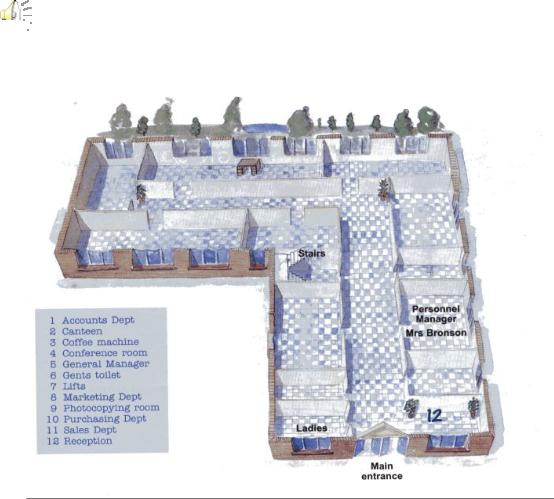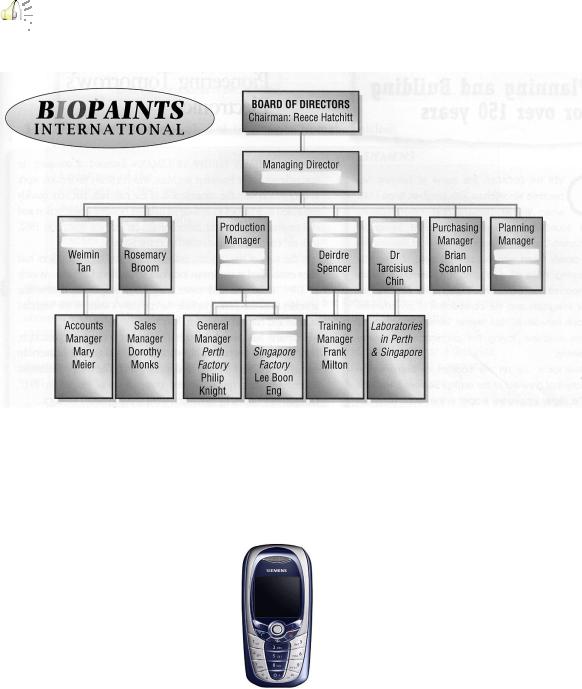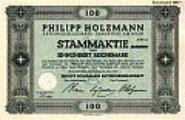
BusinessEnglish_Nikolaenko
.pdf
Exercise 8. Read the text below about different ways of organizing companies, and then label the diagram, according to which of these they illustrate:
line structure |
matrix structure |
functional structure |
staff structure |
A B C D
COMPANY STRUCTURE
Most organizations have a hierarchical or pyramidal structure, with one person or a group of people at the top, and an increasing number of people below them at each successive level. There is a clear line or chain of command running down the pyramid. All the people in the organization know what decisions they are able to make, who their superior (or boss) is (to whom they report), and who their immediate subordinates are (to whom they can give instructions).
Some people in an organization have colleagues who help them: for example, there might be an Assistant to the Marketing Manager. This is known as a staff position: its holder has no line authority, and is not integrated into the chain of command, unlike, for example, the Assistant Marketing Manager, who is number two in the marketing department.
Yet the activities of most companies are too complicated to be organized in a single hierarchy. Shortly before the First World War, the French industrialist Henry Fayol organized his coal-mining business according to the functions that it had to carry out. He is generally credited with inventing functional organization. Today, most large manufacturing organizations have a functional structure, including (among others) production, finance, marketing, sales, and personnel or staff departments. This means, for example, that the production and marketing departments cannot take financial decisions without consulting the finance department.
Functional organization is efficient, but there are two standard criticisms. Firstly, people are usually more concerned with the success of their department than that of the company, so there are permanent battles between, for example, finance and marketing, or marketing and production, which have incompatible goals. Secondly, separating functions is unlikely to encourage innovation.
Yet for a large organization manufacturing a range of products, having a single production department is generally inefficient. Consequently, most large companies are decentralized, following the model of Alfred Sloan, who divided General Motors into separate operating divisions in 1920. Each division had its own engineering, production and sales departments, made a different category of car (but with some overlap, to encourage internal competition), and was expected to make a profit.
Businesses that cannot be divided into autonomous divisions with their own markets can simulate decentralization, setting up divisions that deal with each other using internally determined transfer prices. Many banks, for example, have established commercial, corporate, private banking, international and investment divisions.
61
An inherent problem of hierarchies is that people at lower levels are unable to make important decisions, but have to pass on responsibility to their boss. One solution to this is matrix management, in which people report to more than one superior. For example, a product manager with an idea might be able to deal directly with managers responsible for a certain market segment and for a geographical region, as well as the managers responsible for the traditional functions of finance, sales and production. This is one way of keeping authority at lower levels, but it is not necessarily a very efficient one. Thomas Peters and Robert Waterman, in their well-known book In Search of Excellence, insist on the necessity of pushing authority and autonomy down the line, but they argue that one element - probably the product - must have priority; four-dimensional matrices are far too complex.
A further possibility is to have wholly autonomous, temporary groups or teams that are responsible for an entire project, and are split up as soon as it is successfully completed. Teams are often not very good for decision-making, and they run the risk of relational problems, unless they are small and have a lot of self-discipline. In fact they still require a definite leader, on whom their success probably depends.
Which of the following three paragraphs most accurately summarizes the text, and why?
First summary:
Although most organizations are hierarchical, with a number of levels, and a line of command running from the top to the bottom, hierarchies should be avoided because they make decision-making slow and difficult. A solution to this problem is matrix management, which allows people from the traditional functional departments of production, finance, marketing, sales, etc. to work together in teams. Another solution is decentralization: the separation of the organization into competing autonomous divisions.
Second summary:
Most business organizations have a hierarchy consisting of several levels and a clear line of command. There may also be staff positions that are not integrated into the hierarchy. The organization might also be divided into functional departments, such as production, finance, marketing, sales and personnel. Larger organizations are often further divided into autonomous divisions, each with its own functional sections. More recent organizational systems include matrix management and teams, both of which combine people from different functions and keep decision-making at lower levels.
Third summary:
Most businesses are organized as hierarchies, with a clear chain of command: a boss who has subordinates, who in turn have their own subordinates, and so on. The hierarchy might be internally divided into functional departments. A company offering a large number of products or services might also be subdivided into autonomous divisions. Communication among divisions can be improved by the introduction of matrix management or teams.
The text mentions the often incompatible goals of the finance, marketing and production (or operations) departments. Classify the following strategies according to which departments would probably favour them:
1.a factory working at full capacity
2.a large advertising budget
62

3.a large sales force earning high commission
4.a standard product without optional features
5.a strong cash balance
6.a strong market share for new products
7.generous credit facilities for customers
8.high profit margins
9.large inventories to make sure that products are available
10.low research and development spending
11.machines that give the possibility of making various different products
12.self-financing (using retained earnings rather than borrowing)
Exercise 9. Sentences 1 to 9 make up a short text about different ways in which companies can be structured. Complete each sentence, by taking a middle part from the second box and an end from the third box:
1.Most organizations have a hierarchical or pyramidal structure,
2.A clear line or chain of command runs down the hierarchy,
3.Some people in an organization have an assistant who helps them;
4.Yet the activities of most large organizations are too elaborate
5.Large companies manufacturing a wide range of products, e.g. General Motors,
6.Businesses that cannot be divided into autonomous divisions with their own markets
7.An inevitable problem with hierarchies is that people at lower levels
8.One solution to this problem is matrix management, in which people report to more than one superior:
9.Another, more recent, idea is to have a network of flexible groups or teams,
a.are normally decentralized into separate operating divisions,
b.are unable to make important decisions, but are obliged to pass on responsibility to their boss,
c.can simulate decentralization, setting up divisions that use
d.instead of the traditional departments, which are often at war with each other;
e.so that all employees know who their superior or boss is, to whom they report,
f.e.g. a brand manager with an idea can deal directly with
g.this is an example of a staff position: its holder has no line authority,
h.to be organized in a single hierarchy, and require functional organization,
i.with a single person or a group of people at the top,
j.and an increasing number of people below them at each successive level.
k.and is not integrated into the chain of command.
l.and who their immediate subordinates are, to whom they can give instructions.
m.each with its own engineering, production and sales departments.
n.internally determined transfer prices when dealing with each other.
o.the appropriate managers in the finance, manufacturing and sales departments.
p.they are formed to carry out a project, after which they are dissolved and their members reassigned.
q.unless responsibilities have been explicitly delegated.
r.usually with production or operations, finance, marketing and personnel departments.
63
Exercise 10. Complete the text using the correct form of the following verbs:
achieve |
allocate |
balance |
deal with |
develop |
|
|
employ |
establish |
follow |
require |
set |
|
|
The top managers of a company (1) have to ......... |
objectives and then develop particular |
|||||
strategies that will enable the company to (2)......... |
them. This will involve (3)......... |
the |
||||
company’s human, capital and physical resources. Strategies can often be sub-divided into tactics - the precise methods in which the resources attached to a strategy are (4)
......... .
The founders of a business usually establish a “mission statement” - a declaration about what the business is and what it will be in the future. The business’s central values and objectives will (5) ......... from this. But because the business environment is always changing, companies will occasionally have to modify or change their objectives. It is part of top management’s role to (6) ......... today’s objectives and needs against those of the future, and to take responsibility for innovation, without which any organization can only expect a limited life. Top managers are also expected to set standards, and to (7)
......... human resources, especially future top managers.
They also have to manage a business’s social responsibilities and its impact on the environment. They have to (8) ........... and maintain good relations with customers, major suppliers, bankers, government agencies, and so on. The top management, of course, is
also on permanent stand-by to (9) |
......... major crises. |
Between them, these tasks (10) ......... |
many different skills which are almost never found |
in one person, so top management is work for a team. A team, of course, is not the same as a committee: it needs a clear leader, in this case the chairman or managing director.
Complete the following collocations:
11.to set .........
12.to allocate .........
13. to ......... |
responsibility |
|
14. to ......... |
standards |
|
15. to ......... |
and ......... |
good relations |
16. to ......... |
a crisis |
|
Exercise 11. Complete the text using the following verbs:
appointed attacked combined defined constituted reviewed supervised supported
Large British companies generally have a chairman of the board of directors who oversees operations, and a managing director (MD) who is responsible for the day-to-day running of the company. In smaller companies, the roles of chairman and managing director are
usually (1)......... . |
Americans tend to use the term president rather than chairman, and |
|||
chief executive officer (CEO) instead of managing director. The CEO or MD is (2)......... |
||||
by various executive officers or vice-presidents, each with clearly (3)......... |
authority and |
|||
responsibility (production, marketing, finance, personnel, and so on). |
|
|
||
Top managers are (4) ......... |
(and sometimes dismissed) by a company’s board of directors. |
|||
They are (5) ......... |
and advised and have their decisions and performance (6) ......... |
by the |
||
64

board. The directors of private companies were traditionally major shareholders, but this does not apply to large public companies with wide share ownership. Such companies should have boards (7)......... of experienced people of integrity and with a record of performance in a related business and a willingness to work to make the company successful. In reality, however, companies often appoint people with connections that will impress the financial and political milieu. Yet a board that does not demand high performance and remove inadequate executives will probably eventually find itself
(8)......... and displaced by raiders.


 Exercise 12. You’ll hear a new employee being told where the different offices are in the firm he has just joint. Listen to the conversation and number the rooms that Michael is shown. The ‘tour’ starts at Mrs. Bronson’s office:
Exercise 12. You’ll hear a new employee being told where the different offices are in the firm he has just joint. Listen to the conversation and number the rooms that Michael is shown. The ‘tour’ starts at Mrs. Bronson’s office:
Exercise 13. Many big firms have lots of different sections and it can be helpful to know which part of the company does what. Look at the following company departments. Which department does which job?
Human Resources:
Production:
Marketing:
Finance:
65
Sales, Financial Services, Quality, Training, Payroll, Production, Advertising, Accounts,
Distribution, Maintenance, Marketing, Customer Service, Purchasing, Personnel,
Packaging
Exercise 14. What department does which job? Match each job from the column on the left to a company department from the column on the right:
1. |
puts the product into boxes? |
A. |
Training |
2. |
pays wages and salaries? |
B. |
Production |
3. |
plans how to promote products? |
C. |
Marketing |
4. |
has systems to prevent mistakes? |
D. |
Purchasing |
5. |
looks after the equipment? |
E. |
Personnel |
6. |
deals with complaints? |
F. |
Packaging |
7. |
manufactures the products? |
G. |
Sales |
8. |
sends invoices to customers? |
H. |
Accounts |
9. |
buys equipment? |
I. |
Payroll |
10. |
arranges credit facilities? |
J. |
Distribution |
11.helps staff develop new skills? |
K. |
Customer Service |
|
12. |
sends products to the customer? |
L. |
Financial Services |
13. |
buys media space? |
M. Quality |
|
14. |
recruits new staff? |
N. Advertising |
|
15. |
sends representatives to visit |
O. Maintenance |
|
|
customers? |
|
|
|
|
|
|
Exercise 15. Imagine that an important visitor is coming to your firm. She has sent you this fax. Draft a fax to Ms. Trosborg arranging the date and the time you propose for the visit:
TIVOLI DESIGN CONSORTIUM |
|
BERSTORFFSGADE 19, DK-1577 |
COPENHAGEN, DENMARK |
Telephone: +(45) 72 14 33 21 Fax: |
+(45) 56 39 42 38 |
TO: Publicity Office/Manager |
|
Dear Sir or Madam, |
|
We have heard from one of our mutual customers that your company is involved in a number of interesting design projects.
As I am shortly staying in your city on business, I am writing to enquire whether it would be convenient to visit your office.
I shall be in town from 14th to 18th November. I would be free any morning from 11.30 onwards and in the afternoon of 15th November.
66

I would be extremely grateful if you could confirm whether a brief visit could be arranged on one of the days and at the times suggested.
I look forward to hearing from you.
Yours faithfully,
Anita Trosborg
Design Director


 Exercise 16. Listen to the recording and fill in the names and titles or job descriptions that are missing:
Exercise 16. Listen to the recording and fill in the names and titles or job descriptions that are missing:
Exercise 17. Read the following passages about two companies. Decide which of the headlines goes with which passage:
Planning and Building for Over 150 years Pioneering Tomorrow’s Electronics
1. Over the decades the name with progress. Since 1847, when Halske founded the Siemens & Company in Berlin, the history of the development of electrical firm, Siemens & Halske telegraphy with the first pointer extensive telegraph network. In dynamo machine, laying the
of Siemens has become synonymous Werner Siemens and Johann Georg Halske Telegraph Construction Siemens has been closely linked with engineering. While still a fledgling spearheaded the evolution of telegraph and the construction of an 1866 Werner Siemens invented the cornerstone of power engineering.
67

New ideas are an old tradition of Siemens. The company that grew out of the original Siemens & Halske is today a highly innovative leader in the world electrical and electronics market. Composed of Siemens AG and an array of domestic and foreign subsidiaries, the contemporary Siemens organization continues to set milestones on the road of progress.
Siemens maintains its own production facilities in more than 50 countries and operates a worldwide sales network. With more than 300,000 employees, it is one of the largest companies in the world electrical/electronics industry, having recorded annual sales of DM 82 billion in the 1992/93 fiscal year. Reliable and farsighted management is united with the youthful dynamism and zest for innovation that typify the company.
2. In 1849, Johann Philipp Holzmann founded a company in Sprendlingen, near Frankfurt am Main, which initially undertook work in connection with the construction of the railroads, but very quickly expanded its activities to include all fields of building construction and civil engineering. The first major foreign project was started in 1882, with the contract for Amsterdam’s Central Station.
By the turn of the century, branch offices and regional offices had been established at numerous locations throughout Germany. As early as 1885, Holzmann had more than 5,000 employees. Interesting activities from this period include the company’s work on
the Baghdad railroad and railroad projects in East Africa. |
|
|
|
|
|
|||
Holzmann |
has |
passed |
through |
all |
forms |
of |
||
company organization, from |
individual proprietorship via |
|||||||
a limited |
and |
general |
partnership |
through |
to |
a |
||
GmbH |
(limited |
liability |
company). |
The |
Philipp |
|||
Holzmann |
|
|
Aktiengesellschaft |
(public |
||||
limited |
company) |
was |
formed in 1917. |
Companies |
||||
founded by Holzmann were |
active in South America. |
|
||||||
Even following the losses of manpower and assets during the Second World War, Holzmann was able, as early as 1950, to recommence its foreign activities. 1979 saw the acquisition of J.A. Jones Construction Company, of Charlotte, North Carolina, USA, a major American corporation active in the construction field. This was followed in 1981 by the purchase of Lockwood Green Engineers, Inc., Spartanburg, South Carolina, USA. Together with its USA subsidiaries Holzmann has responded to the changes occurring in the construction industry with a flexible and versatile corporate strategy.
The takeover in early 1989 of the Steinmüller Group, one of Germany’s leading companies in the sectors of power engineering, process engineering and environmental protection demonstrates this.
Exercise 18. Complete the information missing in the table:
Dates |
What happened? |
Who did what? |
1847 |
|
|
1849 |
|
|
|
Invention of dynamo machine |
|
|
First large foreign order begun |
|
1885 |
|
|
|
Aktiengesellschaft founded |
|
68

1950
Acquisition of J.A. Jones Construction
Company
1981
1989
Recorded annual sales of DM 82 billion
Exercise 19. Complete the following table with information from the articles:
HOLZMANN SIEMENS
Locations of the company’s activities
Activities of both companies up to 1940s
Recent activities of the companies
Exercise 20. Read the following text and answer some questions below:
RE-ENGINEERING THE CORPORATION
“It’s not called redundancy these days ... It’s called downsizing”
If you want to stay in step with the latest management trend, fire half your staff. That’s the advice of Michael Hammer and James Champy in their best-selling book ‘Reengineering the Corporation’. For Business Process Re-engineering or BPR is about smashing up the corporate hierarchies we’re used to and rebuilding them from scratch. And the result is that tens of thousands of managers are losing their jobs in the name of reinventing the corporation. In fact, some say that, if BPR really caught on, 25 million Americans would be made redundant tomorrow. Of course, it’s not called redundancy these days. It’s called downsizing. But it means the same thing to an out-of-work executive.
Out with vertical hierarchy
According to Tom Peters, a management guru who’s clearly more excited about BPR than the 25 million looking at impending unemployment, what a lot of large companies are learning is that they can do better with four layers of management than with twelve. The vertical hierarchy is out. The new, streamlined ‘horizontal network’ is in. And gone are the days of the autocratic kings of industry - the Lee Iaccocas and John Sculleys of this world - for now the customer is king.
From the bottom up
Basically, BPR is a mixture of Japanese lean, flexible, ‘just in time’ production and American enthusiasm for re-structuring companies from the bottom up. What it means is that, in order to remain competitive, we’ll all have to forget the old bureaucratic empires, divided by function into separate departments such as sales and accounts. We’ll be organizing ourselves instead around continuous business processes aimed at getting the product to the customer.
Empowerment or madness?
In fact, ‘re-engineers’ say that by the year 2000 it’ll be team-players and not leaders that businesses will chiefly be looking for. And, when it comes to decision-making, middle management may increasingly find itself bypassed altogether, as more and more
69
responsibility is passed down the line to cross-functional teams of junior managers and shopfloor workers. For by then these will have become largely self-managing, and the corporate pyramid will be turned completely upside down. BPR enthusiasts call this ‘empowerment’. Others call it madness.
Mini-companies the way ahead
But is it even that? Or is it just a sexy new name for an old idea? In Sweden, where the top 20 firms do 80% of their business abroad, companies like the manufacturing giant, ABB, have already done something remarkably similar to re-engineering by breaking up the firm into hundreds of mini-companies. IBM had the same idea when it decided to form independent mini-companies of its own and ‘Big Blue’ set up thirteen little ‘Baby Blues’. But, whereas ABB has managed to halve the development time of its products, IBM has not been able to keep pace with its smaller, fitter competitors.
The customer comes first
For BPR does seem to work better in some countries than in others. In the fast-growing economies of East Asia and Latin America, for example, it’s doing well. But things don’t look quite so good in the USA, and in Central Europe it’s even worse. Paternalistic German bosses, in particular, find it hard to delegate responsibility to subordinates and yet overpaid German workers cost their companies 50% more than the average American costs theirs. Many French executives, too, still find it difficult to accept that the customer comes first. And in recession-battered Britain BPR is, more often than not, just an excuse to cut back and get rid of unwanted staff. Perhaps they should be getting rid of BPR instead.
What is your immediate reaction to the article? Tick the response nearest to your own or sum up what you think in a single sentence:
1.I think it paints a rather negative picture.
2.I think it oversimplifies the issue.
3.I think it’s a bit one-sided.
4.I think it makes some interesting points.
5.I think it argues its case extremely well.
6.I think .....
Without referring back to the article, how much can you remember about:
7.mass redundancies
8.the managerial ladder
9.the customer
10.teamwork
11.mini-companies
12.cultural attitudes
Find the expressions in the article which mean:
13.the latest ‘fashion’
14.right from the beginning
15.became popular
16.unemployed executive
17.management expert
18.completely restructure at all levels
19.may be excluded
70
